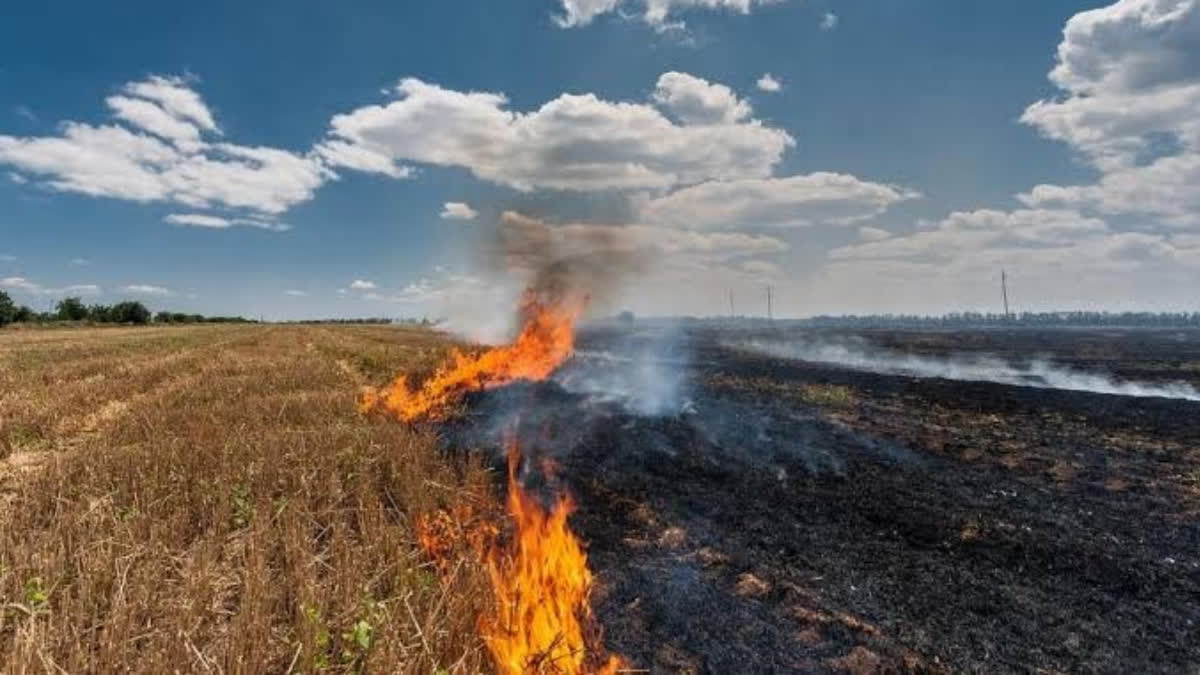New Delhi:Cases of stubble burning in six Indian states have witnessed a sharp decline of 71.58 per cent between 2021 and 2024, according to data released by the Indian Council of Agricultural Research (ICAR).
The total number of stubble-burning incidents decreased by 58,025 during this period, signalling progress in tackling one of the major contributors to air pollution in northern India. However, despite this significant improvement, the air quality in Delhi and its surrounding National Capital Region (NCR) remains dangerously poor, prompting severe health concerns.
Environmentalist Manu Singh speaks to ETV Bharat (ETV Bharat) Between September 15 and November 15, 2024, ICAR recorded 23,035 incidents of stubble burning across six states, compared to 45,425 during the same period in 2023, 58,551 in 2022, and 81,060 in 2021. Punjab continues to account for the largest share, with 7,864 incidents in 2024—a considerable drop from 30,661 cases the previous year.
Haryana, Uttar Pradesh, and Madhya Pradesh have also reported fewer cases this year, with Delhi recording merely 12 incidents, the lowest among the states.
Despite these encouraging numbers, the reduction in stubble burning has done little to alleviate the pollution crisis in Delhi NCR. The Air Quality Index (AQI) in the region has persistently remained in the “severe” category, with thick smog enveloping the area.
Environmentalist Manu Singh describes the situation as grim, stating, “Although there has been a considerable decline in stubble burning due to a strict vigil by six state governments, the air quality in Delhi NCR and across northern India, even extending to parts of Pakistan, continues to worsen.”
Why Does The Air Crisis Persist? Singh highlights multiple factors contributing to Delhi’s hazardous air quality, particularly during winter.
"It’s not just about stubble burning. There’s a natural phenomenon—a standstill, or ‘air doldrum’—that occurs before and during winter. This prevents pollutants, particularly PM2.5 and PM10, from dispersing,” he explains.
These fine particulate matter are known to severely impact respiratory and cardiovascular systems, posing a heightened risk for those with pre-existing conditions such as asthma or heart disease.
Manu Singh further points out human activities as a key driver of pollution. “Even with a blanket ban on crackers, violations were rampant during festive celebrations. Rivers are polluted daily, and the sheer population density of this region—the highest in the world—intensifies pollution from human activities. Burning fossil fuels, using open fires to keep warm, and cultural practices like bursting crackers and stubble burning all contribute to this crisis,” Singh asserts.
He suggests that long-term solutions must include both cultural shifts and population control. “We need to rethink our dependence on fossil fuels, regulate cultural activities that harm the environment, and tackle overpopulation. Without these measures, the air quality in this region will remain a public health disaster,” he warns.
Government Interventions and Challenges: To combat the alarming pollution levels, the Graded Response Action Plan (GRAP) has been implemented in phases. Measures under GRAP include restrictions on construction activities, halting non-essential industries, banning diesel generators, and limiting vehicular emissions. Despite these steps, the pollution levels remain high, exacerbated by weather conditions and unchecked violations of environmental norms.
ICAR’s satellite monitoring efforts to track stubble burning have proven instrumental in enforcing measures to curb the practice. However, the persistent pollution problem in NCR underscores the need for broader, more comprehensive strategies. Experts advocate for integrating renewable energy, promoting sustainable farming practices, and enforcing stricter penalties for violations of pollution control regulations.
Health Concerns Mount:The poor air quality in Delhi NCR continues to affect public health. Residents report symptoms such as breathing difficulties, persistent coughs, and eye irritation. The long-term effects of prolonged exposure to hazardous air, especially after the COVID-19 pandemic, are a growing concern among health professionals.
While the decline in stubble-burning incidents offers a glimmer of hope, it is clear that air pollution in the region cannot be attributed to a single source. A collaborative and sustained effort is essential to address the multifaceted causes of pollution and protect the health of millions living in northern India.
The fight against air pollution is far from over but with stricter regulation implementation and a collective shift in societal habits, a cleaner, healthier future might still be achievable.
Read More:
- Smog Siege In Delhi: Severe AQI Sparks Vehicle Bans And Emergency Measures
- AQI 408: Delhi Spews Toxic Air, People Fune Over Lack of Effective Pollution Control Measures
- Satellite Data Helps States Frame Policies On Stubble Burning
